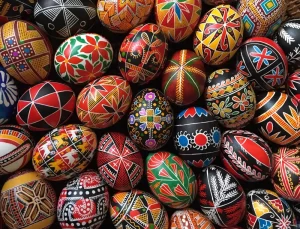by Andrew Fedynsky
Article previously published in the Ukrainian Weekly in June 2020.
“Стихія” (stykhiya): it’s a wonderful Ukrainian word conveying an overwhelming elemental force of nature: a hurricane, drought, famine, locust infestation, forest fire, flood, plague. But it also has a social/political connotation characterizing as “стихія” a population erupting in massive, seemingly spontaneous actions: a national uprising, a revolution.
Ukrainian history is rife with these kinds of “стихії” (plural). For generations, peasants endured serfdom and national oppression until Bohdan Khmelnytsky in 1648 was moved to right a personal wrong and, to his astonishment, channeled pent-up rage to establish the first Ukrainian state since Kyivan Rus’. His statue dominates St. Sophia Square in Kyiv. More recently, we had the Orange Revolution in 2004-2005 and the Revolution of Dignity in 2013-2014 – both spontaneous, both transformative.
It seems to me, America is now experiencing a “стихія.” It was sparked by the video of handcuffed and helpless George Floyd, a Black man lying on his back as a white policeman nonchalantly asphyxiates him. That horrific moment has evoked universal revulsion and worldwide demonstrations. How that came to be the tipping point at this specific time is a question future historians will study, but to appreciate its source, consider the incalculable number – tens, perhaps hundreds of millions – of similar incidents over the years, decades and centuries since Africans were first brought to America as slaves 400 years ago. What’s different today is how police body cameras, bystanders with iPhones and random security cameras record incidents like the assault on Mr. Floyd and send them to the world. The video of his death almost immediately went “viral,” an eerie echo of the coronavirus gripping America and the world (a “стихія”).
I’m an immigrant who came to America in 1948 when I was 8 months old. Growing up in Cleveland, I experienced discrimination – probably most humiliating when I was 10 years old in 1958 and a fifth grader at Benjamin Franklin School. I took January 7 off from school to celebrate Ukrainian Christmas with my family. The next morning, Miss M. announced to the class that I had been truant, which would be recorded on my “permanent record” and I would therefore never be accepted to a major American university.
American History records how common hostile attitudes toward immigrants and their “alien practices” have been, targeting Irish, Chinese, Japanese, Jewish, Italian and other communities. For me, that mindset spilled out into the school yard and I’d come home with a fat lip from fighting bullies who taunted me as a “DP” (displaced person). I replied in kind and gave as good as I got. Ironically, I learned much later that my tormentors were grandchildren of Ukrainian and Irish immigrants.
My fifth grade teacher notwithstanding, in 1965 I enrolled in the University of Notre Dame – all-male and almost exclusively white – because of its sophomore studies program in Innsbruck, Austria, the city where I was born a DP.
I grew up in a blue-collar neighborhood in Cleveland where I received a first rate, 100 percent segregated, public school education. The first time I sat in a classroom with an African American was freshman year in college.
Being heavily engaged from my earliest years in the diaspora Ukrainian community, I was limited when it came to integration into mainstream America. As a result, I found my freshman year difficult; it was hard to relate to classmates who I perceived came from well-to-do mainstream American families, at least compared to mine. In the tight dormitory environment, I buried conflicted feelings about my Ukrainian identity, even as I was reminded of it. A guy in the room next to mine would coin nicknames: usually vulgar and derogatory. I was the “refugee bastard.”
About that time, Notre Dame President Father Theodore Hesburgh launched a concerted campaign to integrate the university. I was 18 and feeling marginalized, was more comfortable relating to two African American basketball players, their room in the freshman dorm just three or four doors away.
In 1965 Civil Rights was the social movement in America with Freedom Riders, Martin Luther King Jr., Malcolm X, Stokely Carmichael and others working to dismantle Jim Crow and integrate Black America. That’s what we talked about.
During late-night discussions with Bob Whitmore and Dwight Murphy, I expressed a tolerant, liberal position on civil rights, which I held then, espoused as an inner city school teacher in Cleveland in the 1970s and which I hold today. Not all Americans are prejudiced, I said, and to prove it added: “I’d let a Black family live next door.” Dwight replied: “That’s the problem, Andy. Why does a Black family need your permission or any white person’s to buy a home in your neighborhood?”
Immigrant that I was and discriminated against as I had been, Dwight pointed out that as a white man, I considered myself privileged and entitled. And indeed I was. I grew up with built-in advantages.
Call it what it was and what it is: systemic racism. Its origins go back to slavery and subsequent Jim Crow laws and practices in the generations following. It was embedded in the condescending mindset I had acquired without being aware of it toward Black classmates and in society itself. May I note that my classmates Dwight and Bob graduated from Notre Dame Law School and went on to careers in their communities, helping to transform America. Sadly they have both passed away.
Just as sadly, racism persists in America today, more than half a century after our dormitory talks and after the election in 2008 of a Black president. The statistics speak for themselves: African Americans have fewer educational opportunities, higher incarceration rates, more COVID-19 infections, greater unemployment and, yes, a vastly higher incidence of police stops and deaths from encounters, as illustrated by the death of George Floyd and multiple, high-profile shootings.
Recently, my wife and I received an e-mail inviting us to join the “Ukrainian Antiracist Community.” Led by young folks who grew up interacting with Black folks way more than I did, they want to “advance racial equity in North America,” to work toward systemic change in America and Canada with a specific list of action items. The group asks folks to commit toward that goal, to be part of the “стихія,” the change we need. The goal is laudable and its authors are to be commended. My wife and I signed on. See: https://ukrainianantiracistcommunity.com/.



